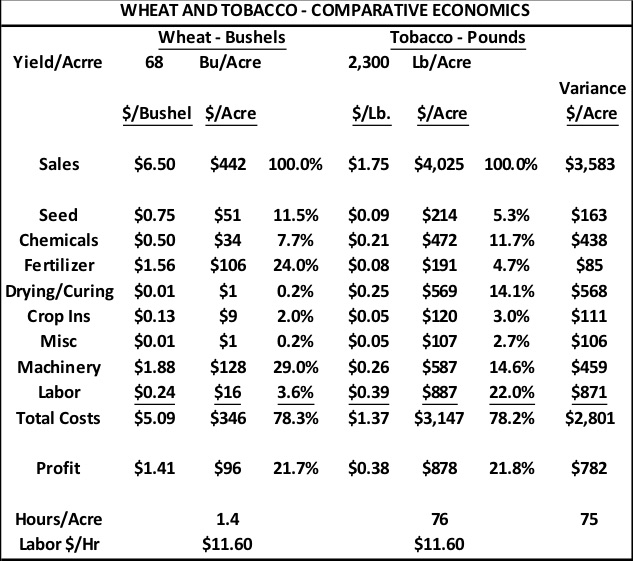Tobacco Crop Economics
Tobacco farmers, with only an acre or two of tobacco, could profit from the crop, even on a small scale. They grew tobacco with little or no capital investment, but with a large amount of labor.
These numbers are from the mid-1980s. The absolute dollars fluctuated over the decades, but the relative costs of wheat and tobacco have remained about the same for the last hundred years.
While the profit margin for each was over 21%, there were big differences in the cost elements. Wheat had to be sowed and harvested with equipment – using tractors, seed drills, and combines. The cost of this big equipment could be justified only if it were used on a large tract of land. Machinery cost was 29% of price while labor was a mere 3.6%. Since nearly all the work was done mechanically, the manual labor was less than two hours per acre.

Tobacco farming was the opposite mix of capital and labor. Tobacco used less than half the amount of machinery required for wheat, and looking back to earlier decades, the 1930s–40s, it required almost no equipment. The labor content is quite another matter. The entire crop was planted, tended, and gathered with long hours of hard, backbreaking labor and a few mules. Even with today’s mechanical tobacco planters and other machinery, labor is still 22% of the cost of producing an acre of tobacco, more than five times the labor required in wheat farming.
But the difference in profit dollars per acre is dramatic. Wheat produces only $96 per acre, while tobacco produces $878, nine times as much. A family with some teen-age children working part-time could grow five acres of tobacco to supplement the income from the parents’ regular jobs and produce nearly $5,000 of badly needed cash income.
The economics of each crop also impacts the land value. A farmer can theoretically pay only about $1,200 for wheat acreage if his target is to make a minimum 6% return on his investment. An acre that can be used for tobacco can justify $13,000 an acre, giving the same expected 6% return.

The tobacco quota system has had much to do with this land price over the years because quotas limited the supply of land for tobacco production. Ever since tobacco moved toward a free market, eliminating acreage quotas in 2004, the value of tobacco acreage has dropped because tobacco can be now be grown anywhere, and supply is no longer restricted. Economies of scale have become more significant for tobacco just as they have always been for wheat and other grains. This explains why tobacco crops in North Carolina have gravitated east, leaving behind the small hilly plots in the Piedmont for the vast flat acreage available in the Coastal Plain.
Bullen, S. Gary. “Cost of Production 2012 Tobacco Budgets.” North Carolina State University – Tobacco, 2012. https://tobacco.ces.ncsu.edu/wp-content/uploads/2012/07/tobacco-production-cost-2011-1.pdf ?fwd=no
Vocke, Gary and Ali, Mir. “U.S. Wheat Production Practices, Costs, and Yields.” USDA Economic Research Service, Bulletin 116, August 2013. https://www.ers.usda.gov/webdocs/publications/ 43783 /39923_eib116.pdf?v=41516
Bullen, S. Gary. “Cost of Production 2012 Tobacco Budgets.” North Carolina State University – Tobacco, 2012. https://tobacco.ces.ncsu.edu/wp-content/uploads/2012/07/tobacco-production-cost-2011-1.pdf ?fwd=no
Vocke, Gary and Ali, Mir. “U.S. Wheat Production Practices, Costs, and Yields.” USDA Economic Research Service, Bulletin 116, August 2013. https://www.ers.usda.gov/webdocs/publications/ 43783 /39923_eib116.pdf?v=41516